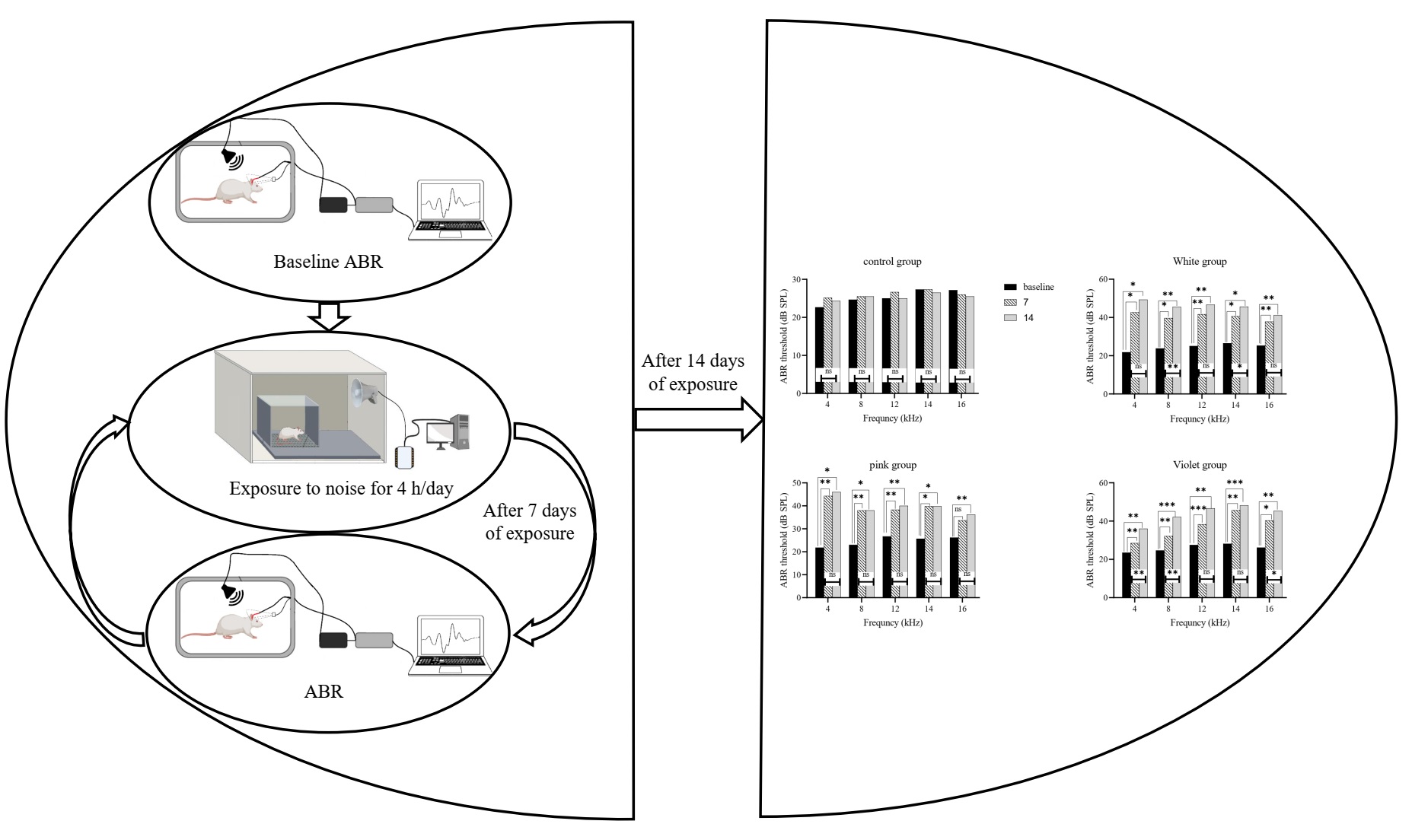Volume 13, Issue 2 (6-2023)
J Health Saf Work 2023, 13(2): 236-251 |
Back to browse issues page
Download citation:
BibTeX | RIS | EndNote | Medlars | ProCite | Reference Manager | RefWorks
Send citation to:



BibTeX | RIS | EndNote | Medlars | ProCite | Reference Manager | RefWorks
Send citation to:
Rezaei-Hachesu V, Haddadzade Niri H, Farahani S, Monazzam Esmaeelpour M R. Frequency-Based Analysis of Auditory Threshold Shifts Induced by Noise Color in Rats. J Health Saf Work 2023; 13 (2) :236-251
URL: http://jhsw.tums.ac.ir/article-1-6840-en.html
URL: http://jhsw.tums.ac.ir/article-1-6840-en.html
Vida Rezaei-Hachesu1 
 , Hassan Haddadzade Niri2
, Hassan Haddadzade Niri2 
 , Saeid Farahani3
, Saeid Farahani3 
 , Mohammad Reza Monazzam Esmaeelpour *
, Mohammad Reza Monazzam Esmaeelpour * 
 4
4

 , Hassan Haddadzade Niri2
, Hassan Haddadzade Niri2 
 , Saeid Farahani3
, Saeid Farahani3 
 , Mohammad Reza Monazzam Esmaeelpour *
, Mohammad Reza Monazzam Esmaeelpour * 
 4
4
1- Department of Occupational Health Engineering, School of Public Health, Tehran University of Medical Sciences, Tehran, Iran
2- Rehabilitation Research Center, Department of Audiology, School of Rehabilitation Sciences, Iran University of Medical Sciences, Tehran, Iran
3- Department of Audiology, School of Rehabilitation Sciences, Tehran University of Medical Sciences, Tehran, Iran
4- Department of Occupational Health Engineering, School of Public Health, Tehran University of Medical Sciences, Tehran, Iran ,smaeel@tums.ac.ir
2- Rehabilitation Research Center, Department of Audiology, School of Rehabilitation Sciences, Iran University of Medical Sciences, Tehran, Iran
3- Department of Audiology, School of Rehabilitation Sciences, Tehran University of Medical Sciences, Tehran, Iran
4- Department of Occupational Health Engineering, School of Public Health, Tehran University of Medical Sciences, Tehran, Iran ,
Abstract: (1304 Views)
Introduction: Colored noises with acoustic and psychoacoustic characteristics have several biological effects on human or animal health. While studies on auditory effects focus on noise’s physical aspects, its psychoacoustic aspects can also result in health and safety risks. Therefore, this study aims to investigate frequency-based damages due to exposure to colored noise in an animal model.
Material and Methods: Twenty-four male Wistar rats were randomly divided into four groups (6 in each group). The groups included the control (no exposure) and three exposure groups (white, pink, and violet). The rats were exposed to 110 dB SPL for 4 hr/day for 14 consecutive days. Auditory brainstem responses (ABR) with click and tone-burst stimuli were recorded one day before (baseline), 7, and 14 days after exposure. Statistical analyses were conducted using ANOVA and repeated measures ANOVA.
Results: There was a statistically significant increase in ABR threshold values in exposure groups (p<0.05). Hearing threshold shifts in the white noise group showed a homogeneous pattern, violet noise showed an increasing pattern, and pink noise showed a decreasing pattern in low frequencies and a homogeneous pattern with increasing frequency. The highest shift in hearing threshold was observed in exposure groups from day 0 to 14. Additionally, the shift in hearing threshold in the second week was less than in the first one.
Conclusion: The current study observed that noise’s power spectral density affected hair cells’ damage severity. Accordingly, pink noise causes less damage to the cochlea compared to white and violet. Over time after noise exposure, cochlear pathogenesis gradually decreases and hair cell lesions become stable.
Material and Methods: Twenty-four male Wistar rats were randomly divided into four groups (6 in each group). The groups included the control (no exposure) and three exposure groups (white, pink, and violet). The rats were exposed to 110 dB SPL for 4 hr/day for 14 consecutive days. Auditory brainstem responses (ABR) with click and tone-burst stimuli were recorded one day before (baseline), 7, and 14 days after exposure. Statistical analyses were conducted using ANOVA and repeated measures ANOVA.
Results: There was a statistically significant increase in ABR threshold values in exposure groups (p<0.05). Hearing threshold shifts in the white noise group showed a homogeneous pattern, violet noise showed an increasing pattern, and pink noise showed a decreasing pattern in low frequencies and a homogeneous pattern with increasing frequency. The highest shift in hearing threshold was observed in exposure groups from day 0 to 14. Additionally, the shift in hearing threshold in the second week was less than in the first one.
Conclusion: The current study observed that noise’s power spectral density affected hair cells’ damage severity. Accordingly, pink noise causes less damage to the cochlea compared to white and violet. Over time after noise exposure, cochlear pathogenesis gradually decreases and hair cell lesions become stable.
Type of Study: Research |
Received: 2023/06/29 | Accepted: 2023/06/22 | Published: 2023/06/22
Received: 2023/06/29 | Accepted: 2023/06/22 | Published: 2023/06/22
Send email to the article author
| Rights and permissions | |
 |
This work is licensed under a Creative Commons Attribution-NonCommercial 4.0 International License. |





